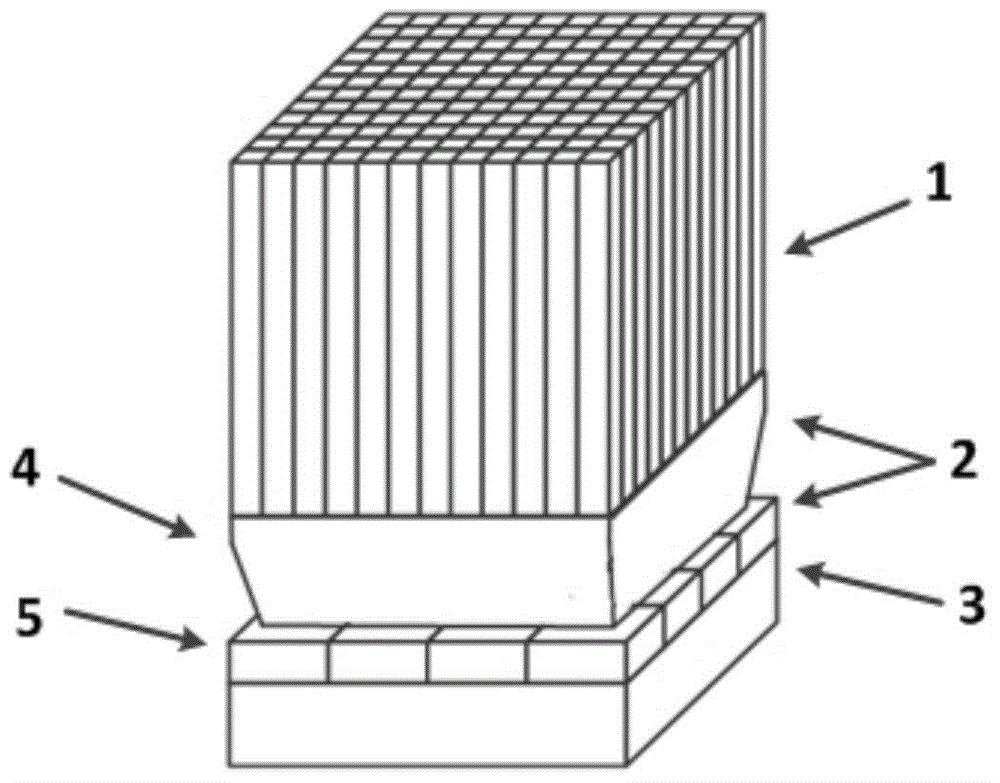Photoelectric converter, detector and scanning equipment
A photoelectric converter and detector technology, applied in the field of nuclear medicine imaging, can solve the problems of high price of position-sensitive photomultiplier tubes, increase the cost of PET system, etc., and achieve the effects of low cost, small size, and improved flexibility
- Summary
- Abstract
- Description
- Claims
- Application Information
AI Technical Summary
Problems solved by technology
Method used
Image
Examples
Embodiment 1
[0048] Such as figure 1 As shown: the detector includes a scintillation crystal 1 , a photoelectric converter 2 , and an electronic system 3 . The scintillation crystal 1 is formed by splicing 12×12 scintillation crystal strips of the same size on a horizontal plane. The bottom surface of the scintillation crystal 1 is directly coupled to the top surface of the light guide 4, and the silicon photomultiplier tube array 5 consists of 4×4 silicon photomultiplier tubes of the same size, wherein the light guide has only one layer, the shape is a cuboid, the material is glass, and the thickness is 13mm. In Electronics System 3, the DPC circuit is firstly used to reduce the number of channels from 16 to 4, and then the Anger-Logic algorithm is used to obtain the deposition position of the γ photon; and, the time to extract the summed signal is the deposition time of the γ photon.
Embodiment 2
[0050] Such as figure 2 As shown: the detector includes a scintillation crystal 1 , a photoelectric converter 2 , and an electronic system 3 . The scintillation crystal 1 is formed by splicing 12×12 scintillation crystal strips of the same size on a horizontal plane. The bottom surface of the scintillation crystal 1 is directly coupled with the top surface of the light guide 4. The silicon photomultiplier tube array 5 consists of 4×4 silicon photomultiplier tubes of the same size, wherein the light guide is only one layer, and its shape is a quasi-conical hexahedron. They are all square, the four sides are trapezoidal, the square areas of the upper and lower surfaces are different, and the thickness is 13mm. In Electronics System 3, the cross-wire circuit is first used to reduce the number of channels from 16 to 8, and then the maximum likelihood estimation method is used to obtain the deposition position of the gamma photon; the method of obtaining the deposition time infor...
Embodiment 3
[0052] Such as image 3Shown: A position-sensitive PET detector based on a silicon photomultiplier tube includes a scintillation crystal 1 , a photoelectric converter 2 , and an electronics system 3 . The scintillation crystal 1 is formed by splicing 12×12 scintillation crystal strips of the same size on a horizontal plane. The bottom surface of the scintillation crystal 1 is directly coupled with the top surface of the light guide 4, and the silicon photomultiplier tube array 5 is composed of 4×4 silicon photomultiplier tubes of the same size, wherein the light guide is only one layer, and its shape is a quasi-conical decahedron, that is, a A cuboid plus a hexahedron (with a continuous light guide in the middle), the upper and lower surfaces of the entire decahedron are squares with different surface areas, and the sides are four rectangles plus four trapezoids, with a total thickness of 13mm. In Electronics System 3, the cross-wire circuit is first used to reduce the number...
PUM
 Login to View More
Login to View More Abstract
Description
Claims
Application Information
 Login to View More
Login to View More - R&D
- Intellectual Property
- Life Sciences
- Materials
- Tech Scout
- Unparalleled Data Quality
- Higher Quality Content
- 60% Fewer Hallucinations
Browse by: Latest US Patents, China's latest patents, Technical Efficacy Thesaurus, Application Domain, Technology Topic, Popular Technical Reports.
© 2025 PatSnap. All rights reserved.Legal|Privacy policy|Modern Slavery Act Transparency Statement|Sitemap|About US| Contact US: help@patsnap.com



